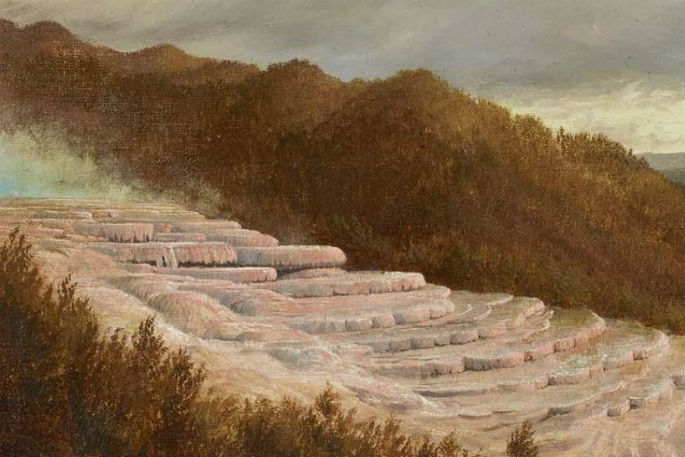Six years after a group of scientists published video of what they claimed are the pink and white terraces beneath Lake Rotomahana, another claim has surfaced.
The recent claims say the terraces are instead onshore and buried under the ash from the 1886 Tarawera eruption.
The volcano erupted on June 10, 1886, blasting a 17km long fissure that crossed the floor of Lake Rotomahana, covering the surrounding countryside metres deep in mud and ash.
Before the eruption, the pink and white terraces on the shore of Lake Rotomahana were an international attraction, considered the eighth wonder of the world.
In 2011, Dr Cornel de Ronde from Woods Hole Oceanographic Institution (WHOI) announced scientists from the University of Waikato had found the Pink Terrace deep in the lake.
Now, Rotorua author Rex Bunn and Dr Sascha Nolden, curator of the Hochstetter Basel Collection, used unpublished survey data provided by 19th Century geologist, cartographer and artist Dr Ferdinand von Hochstetter to provide a new location for the terraces, on land.
Hochstetter visited the world-famous Te Otukapuarangi and Te Tarata, the Pink and White Terraces, in 1859 and recorded perhaps the best description of them.
Unknown to anyone, his field dairies contained records of a compass survey conducted by Dr Hochstetter over two days at Lake Rotomahana in April, 1859.
The diaries returned to Europe with him in 1859 and were archived by his descendants. Dr Nolden found them in a family cellar in 2010.
The forensic cartography delivered control points which enabled the authors to georeference Hochstetter's survey map over the new Lake Rotomahana map. Black Terrace Crater and Te Ariki datum are derived.
Validation by waterways, valleys and vegetation lines is undertaken, a biological bathymetry completed and three-point resection performed on the key survey station. The cartography shows the Pink, Black and White Terrace spring locations, Te Otukapuarangi, Te Ngawha a Te Tuhi and Te Tarata lie buried 10-15m on land, says Rex.
The authors want a full archaeological site investigation to examine the locations.
'The Terrace locations lie too deeply buried under volcanic ash to be excavated, in my opinion,” says Rex.
'However, it's too early to make such a call. The Hochstetter survey and my derivation of it will doubtless be replicated and any question about exposing the Pink and White Terraces canvassed with the traditional landowners and New Zealand regulatory bodies.
'Now at last we can with fair confidence, say where these wonders of the old world lie today.”
The terraces were formed over about 500 years, from silica rich water flowing down the hillside from boiling geysers.
The water cooled and crystallised into the terraces and pools, forming giant staircases or waterfalls.
The White Terrace was the larger, covering three hectares and descending 30 metres.
The Pink Terrace was where people went to bathe on the lower levels, because the temperature of the water was lukewarm.
In the early hours of June 10, people awoke to earthquakes, lightning, fountains of molten rock, and columns of smoke and ash up to 10 km high.
People as far away as Blenheim heard the eruption. Some thought it was an attack by a Russian warship.



3 comments
8th wonder?
Posted on 13-06-2017 16:36 | By maildrop
It may have been an "attraction" but steady on. I have looked up various lists on "wonders of the world" and it isn't on any. Not even the underwater wonders of the world. I know New Zealand likes to big itself up in all manner of things but claiming wonders of the world is taking the biscuit.
@maildrop
Posted on 13-06-2017 19:54 | By Papamoaner
That was an encyclopaedia you used wasn't it!We all know from numerous previous assertions, that Maildrop NEVER harvests information from the web.
Tunnel
Posted on 14-06-2017 11:49 | By maildrop
Maybe they should build an underwater tunnel so we can all go and look at them. Hehehe.
Leave a Comment
You must be logged in to make a comment.